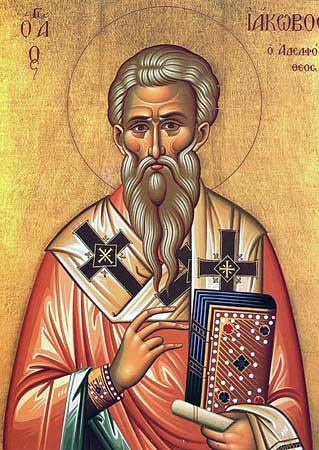James Images and
NotesThe Book of James
James 1:22-25 - But be ye doers of the word, and not hearers
only, deceiving your own selves. For if any be a hearer of the
word, and not a doer, he is like unto a man beholding his
natural face in a glass: For he beholdeth himself, and goeth his
way, and straightway forgetteth what manner of man he was. But
whoso looketh into the perfect law of liberty, and continueth
[therein], he being not a forgetful hearer, but a doer of the
work, this man shall be blessed in his deed.
James 4:17 - Therefore to him that knoweth to do good, and
doeth [it] not, to him it is sin.
James in The New Testament - A Brief Overview

Icon of St. James the Just
Introduction to The
Book of James
Brief Summary. The epistle of James has a clear focus
on the necessity of Christian works, and this is in contrast but
not in conflict with the doctrine of justification by faith set
forth by the apostle Paul. The heart of the book of James takes
one back to the time of Abraham, who believed first before any
works, and he was justified before God. This is because God knew
his heart and saw him through his omniscient eyes. Since man
cannot see into of other men's hearts, he can only see the true
faith of an individual by his works. To James Christian works do
not make a man saved, but is the true test that a genuine
Christian has already received salvation. Some of the points
that James brings up is hearing the word of God and not doing
the word of God, loving worldly possessions more than giving,
not restraining the tongue, not trusting in God's providence,
partiality toward the rich and contempt for the poor, and other
attitudes and actions which would not be in harmony with a "pure
and undefiled religion."
Summary of The Book of James
Author. The author of this epistle identifies himself
as "James, a servant of God and of the Lord Jesus Christ." Most
scholars agree that the book of James was written by James the
Just, brother of our Lord (Matt. 13:55; Gal. 1:9), and leader of
the mother Church at Jerusalem (Gal. 2:9). He is the same James
to whom Jesus appeared, according to the words of Paul, and who
made the speech at the Jerusalem council admitting Gentiles into
the Church. James acted as president of the conference on
circumcision (Acts 15:18; Acts 12:17; 21:18). Paul called him
one of the "pillars of the Church." Josephus spoke of James as a
man of "preeminent justice."
Date. There is no doubt that the book of James was
written before the destruction of Jerusalem in 70 AD, but there
is no way to be certain exactly when the book of James was
written. The Epistle was written from Jerusalem, probably about
61 AD.
Audience. James addresses his book, "to the twelve
tribes which are scattered abroad," which indicates that he was
writing from Jerusalem to the Jews of the "dispersion" and
"my brethren," indicates that these were Jewish Christians
living away from Jerusalem.
Outline of the Book of James
Faith Tested by Trials - Chapter 1
Faith Shown by Works - Chapter 2
Faith Proven by Conduct - Chapters 3-4
With Faith Comes Persecution - Chapter 5

The Name Jesus In Ancient Hebrew Text
"Yeshua" in First Century Hebrew Text. This is how the name "Jesus"
would have been written in ancient Hebrew documents. The four letters or
consonants from right to left are Yod, Shin, Vav, Ayin (Y, SH, OO, A).
Jesus is the Greek name for the Hebrew name Joshua or Y'shua which means
"The LORD or Yahweh is Salvation".
James Maps and Resources
Map of the Roman Empire (14 A.D.) - This map reveals the
Roman Empire during the time shortly after the birth of Jesus,
in 14 AD at the time of the death of Augustus. The order which
prevailed in this extensive empire, the good military roads, and
the use of Koine Greek as the general language of culture
throughout the area were among the factors which multiplied the
rapid spread of the Gospel of Jesus Christ. (Color Map)
Map of Paul's First Missionary Journey (48 A.D.) - This map
reveals the areas in Asia Minor where Paul visited in his first
missionary journey. Around 48 AD, in the springtime, Paul and
his companions Barnabas and Mark were sent on a mission from the
church in Antioch. This would be the first of Paul's Missionary
Journey's. (Color Map)
Map of Paul's Second Missionary Journey (51 A.D.) - This map
reveals the areas in Asia and Greece where Paul visited in his
second missionary journey. Paul re-visits a couple cities in
Asia, one of which was Lystra where he was stoned and left for
dead a few years earlier. He later has a vision that leads him
over to Greece and Paul and his companions travel and minister
in various cities in Greece (Philippi, Thessalonica, Berea,
Athens and Corinth. Later Paul returns to Ephesus and finally to
Caesarea and Antioch. (Color Map)
Map of Paul's Third Missionary Journey (54 A.D.) - This map
reveals the areas in Asia and Greece where Paul visited in his
third missionary journey. On Paul's third missionary journey he
returned to the cities he had first visited on his first
missionary journey. During this time he decided to remain in
Ephesus for about 3 years, and this city was the main focus of
his activities and an important Christian community (Acts 19).
(Color Map)
Map of the New Testament World - This map reveals the
"Nations" within the ancient world during the first century
A.D., the time of the New Testament. The map includes the areas
of Israel, Asia, Greece, and Italy. (Color Map)
Map of New Testament Greece This map reveals the cities
within Greece in the ancient world during the first century
A.D.,The map includes the principal cities of Greece like:
Athens, Corinth, and Thessalonica, and provinces like Macedonia
and Achaia. (Color Map)
Map of New Testament Asia - This map shows the cities within
Asia Minor during the first century A.D., the time of the New
Testament. The map includes the principal cities of Asia
including Tarsus, Ephesus, and Colossae, and provinces like
Galatia and Pamphilia. (Color Map)





